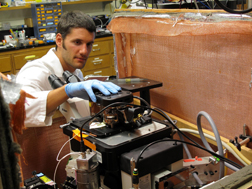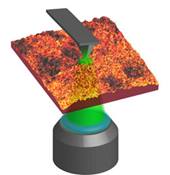Scientists Work to Improve Solar Cell Efficiency
An organic solar cell is a possible low-cost alternative to the silicon photovoltaic cells currently used to harness the energy from the Sun to produce clean, renewable electricity.
Scientists hope that these plastic solar cells will be added to bags and back packs in the future to power small electrical items, like mp3 players, cell phones, and smart phones, and eventually be produced on a large enough scale to contribute to electricity for the grid. In order to make this happen, scientists need to raise the efficiency of these solar cells to something close to 10 percent.
"Making organic solar cells more efficient is crucial to making them viable," said David Ginger, lead author on this study. "And if costs can be brought low enough, solar cells could offset the need for more coal-generated electricity in years to come."
The materials used to make organic solar cells traditionally transport only a single type of charge (positive or negative). To combat this complication, scientists often use a mixture of a polymer that can transport positive charges (like polythiophene) combined with another carbon-based substance (like fullerene) that can transport negative charges. When mixed together, and coaxed into forming the proper nanoscale structure, such a blend can absorb the Sun's light and convert it directly to electricity.
Many attempts to model the efficiency of organic solar cells assume the cells are composed of a uniform slab of material. Ginger equates this approach to improving highway efficiency by increasing the speed limit without taking into consideration how on-ramps and off-ramps alter the flow of cars traveling along the highway.
In reality, organic solar cells are pock-marked with small bubbles and channels of the different (electron-transporting and hole-transporting) materials that form during the baking process, called annealing. These channels alter the characteristics of the polymer and change the way the electrons move, similar to the merging cars on a busy highway.
The channels and bubbles are difficult to study because they are on the order of the nanoscale – roughly 10,000 times smaller than a human hair. "The key to developing an efficient plastic solar cell, said Ginger "is looking at the small picture."
Ginger and colleagues at the University of Washington in Seattle are doing just that—taking pictures of organic solar cell at the nano-level—to image how electrical charges move through solar cells to improve the efficiency and lower production costs.
The research team used a microscopic probe that resembles the needle on an old record player to record electrical currents from sections of the solar cell that are no more than 20 nanometers across.
"We found that there are ‘hot' zones on the solar cell where electrons are conducted efficiently and other zones where holes [positive charges] are conducted efficiently, but the current across the solar cell is not uniform" said Ginger.
Understanding how these nanoscale structures affect solar cell efficiency will allow engineers to design a more efficient model in the next round. The number and configuration of the nanoscale features can be altered by adjusting the baking time and temperature of the polymer.
Early organic solar cells converted sunlight to electricity with less than 1 percent efficiency, while more recent cells are in the range of 6-7 percent efficiency. This value is still below commercially available photovoltaic solar cells with an efficiency rate at 12 to 15 percent. Still, Ginger cautions, without understanding the importance of the nanoscale bubbles and channels, "you could make seven percent in your lab, but end up with a mass-produced cell that's only three percent efficient."

Photo Credit: UW Marketing
University of Washington Chemistry PhD student Obadiah Reid aligns the atomic force microscope used to image local photocurrents in organic solar cells.
Ginger does not anticipate the specific polythiophene/fullerene combination his group examined in this imaging study will reach the efficiency threshold required to make the technology viable, but he is hopeful that some variation of organic semiconductors will. "Basic research addressing the fundamental properties of materials is needed to produce the energy technologies of the future."
 Enlarge Photo
Enlarge Photo
 Photo Credit: Obadiah Reid, University of Washington
Photo Credit: Obadiah Reid, University of Washington
Photoconductive atomic force microscopy is used to take pictures of the nanoscale origins of the photocurrents in polymer solar cells. A laser beam is used to excite photocurrent in the solar cell, which is collected by a conductive atomic force microscope tip.
To meet these needs, Ginger and his colleagues plan to continue optimizing new polymer structures for better performance, and hope to make their imaging techniques more user-friendly so more research groups can incorporate this technology into their practices.
"The solution to the energy problem is going to be a mix, but in the long term solar power is going to be the biggest part of that mix," he said.
This basic science study is supported by the Department of Energy (DOE) Office of Science, Office of Basic Energy Sciences. DOE invests in science and solving critical issues impacting people's daily lives and the nation's future. For more information, visit http://www.science.doe.gov.
The National Science Foundation supported the development of the photoconductivity atomic force microscopy used in this research.
Founded in 1861, the University of Washington is one of the oldest state-supported institutions of higher education on the West Coast and is one of the preeminent research universities in the world with the mission to preserve, advance, and disseminate knowledge. For more information, visit http://www.washington.edu/
References
Pingree, L., O. Reid, and D. Ginger. 2009. Imaging the evolution of nanoscale photocurrent collection and transport networks during annealing of polythiophene/fullerene solar cells. Nanoletters, 9 (8): 2946-2952.
This article was written by Stacy W. Kish.

